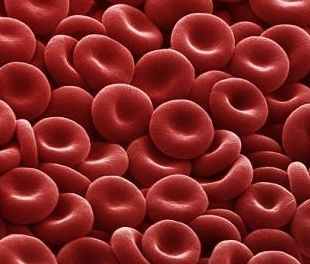

MedFriendly®


Hematocrit
Hematocrit (abbreviated Hct) has the following
meanings in the field of medicine:
1. The percentage of the amount of blood that is
occupied by red blood cells that are packed together. A
capable of existing by itself. Red blood cells help carry
oxygen in the blood.
2. A rarely used term for a device that separates the
cells and other particles in the blood from the plasma.
Plasma is the watery part of the blood.
Red blood cells packed together.
FEATURED BOOK: Mosby's Diagnostic and Laboratory Test Reference
HOW DO THE CELLS BECOME PACKED TOGETHER?
When hematocrit is measured, a substance is added to the blood sample to prevent it
from clotting. Then, as the blood sample is spun around at high speeds in a device called
a centrifuge, the cells become packed together.
HOW IS HEMATOCRIT CALCULATED?
Hematocrit is calculated by multiplying the amount of red blood cells by the amount of
space occupied by the red blood cells. The amount of space occupied by the red blood
"Where Medical Information is Easy to Understand"™
cells is known as the mean corpuscular volume (MCV). Hematocrit
is often considered alongside hemoglobin (known as H&H).
Hemoglobin is Hemoglobin is a red substance (made of iron and
protein) in the blood that carries oxygen to the cells in the body
from the lungs.
WHAT IS AN EXAMPLE OF WHAT HEMATOCRIT WOULD
MEAN?
As an example of what hematocrit would mean, let's say that the
hematocrit value was 45%. This would mean that almost half of
the blood has red blood cells. Specifically, it would mean that there
are 45 milliliters of packed red blood cells in 100 milliliters of blood.

A milliliter is one thousandth of a liter. A liter is a measurement of the amount of space that a liquid takes
up in a container, which is equal to 1.056688 quarts. To understand this better, picture a gallon of milk. It
takes 4 quarts of milk to make up one gallon of milk. Since one liter is a little bit more than one quart, 4
liters of milk is a little bit more than one gallon of milk.
WHAT IS THE NORMAL RANGE OF HEMATOCRIT FOR ADULTS?
In males 19 years or older, the normal range of hematocrit is between 41 and 50%. In females 19 years
or older, the normal range of hematocrit is between 36 and 44%. These values may be different at
different hospitals depending on the equipment used to measure the hematocrit.
WHAT IS THE NORMAL RANGE OF HEMATOCRIT FOR CHILDREN?
At birth, the normal range of hematocrit is between 42 and 64%. After birth up until 1 month of age, the
normal range is between 31 and 67%. Between 1 to 2 months, the normal range is between 28 to 55%.
Between 2 and 6 months, the normal range is between 28 and 42%. Between 6 months to two years, the
normal range is 33 to 40%. Between 2 to 6 years the normal range is between 34 to 40%. Between 6 to
12 years, the normal range is between 35 to 45%. For females between ages 12 and 18, the normal
range is between 36 to 46%. For males between ages 12 and 18, the normal range is between 37 and
49%. These values may be different at different hospitals depending on the equipment used to measure
the hematocrit.
WHAT CAN CAUSE HEMATOCRIT TO BE TOO HIGH?
Many factors can cause hematocrit to be too high. The most common cause is when too much water or
body fluid has left the body. This would cause less fluid in relation to the amount of cells. Hematocrit can
also be high when there is an increased amount of red blood cells in response to a burn injury, shock, or
some other type of trauma. A high hematocrit level can occur during polycythemia vera, which is a
condition of unknown cause in which there is a long-term increase in red blood cells and other types of
cells. Exposure to high elevations for long periods produces an increase in red blood cells so that the
body can receive more oxygen. The reason the body needs more oxygen at high elevations is because
there is a lower amount of oxygen at higher heights.
WHAT CAN CAUSE HEMATOCRIT TO BE TOO LOW?
Hematocrit can be too low because a person is recovering from a sudden loss of a large amount of blood
in a short period of time. With blood loss comes a loss of red blood cells. Anemia can also cause a low
hematocrit level. Anemia is a condition in which there is an abnormally low amount of hemoglobin in the
blood. Hemoglobin is substance present in red blood cells that help carry oxygen to cells in the body. Low
hematocrit can also occur during pregnancy because there is an increased amount fluid in the blood in
relation to the amount of red blood cells.
HOW ELSE IS HEMATOCRIT SPELLED?
Hematocrit is also speed haematocrit.
WHAT ELSE IS HEMATOCRIT CALLED?
People in the medical field often refer to hematocrit as crit.
WHAT IS THE ORIGIN OF THE TERM "HEMATOCRIT"?
Hematocrit comes from the Greek word "haima" meaning "blood," and the Greek word "krino" meaning "to
separate." Put the two words together and you have "to separate blood." The term "hematocrit" was
coined in 1903.














